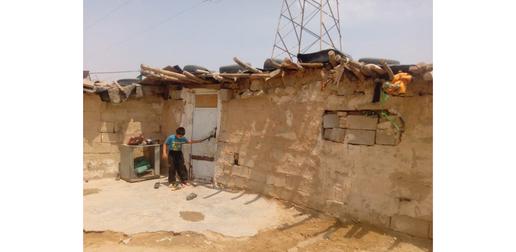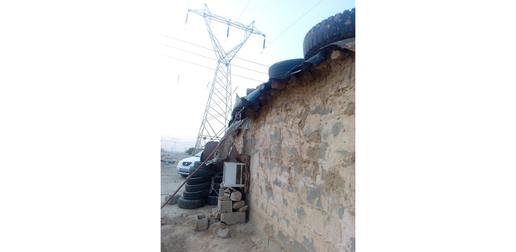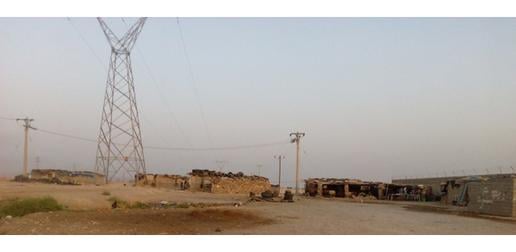One kilometer south of the city of Shushtar in the southwestern province of Khuzestan, a byway leads to a semi-industrialized zone surrounded by workshops for construction material and recycling plants. Pylons are everywhere, supplying 11,000 watts of electricity to the nearby city.
It’s also home to the poorest people in the area. They live both north and south of these high-voltage electrical lines, and have no other place to live. The majority of them are seasonal workers, or else nomadic people whose traditions of moving as the seasons changed have been compromised by the demands of modern city life.
The seasonal workers scrape together a living by doing back-breaking jobs in construction material workshops or collecting garbage. Their homes are built without any adherence to safety standards, or according to any architectural or engineering principles. They are jury-rigged, and made of bricks, cement blocks and tin plates. And above their heads are the high-voltage transmission lines, presenting another set of hazards and likely having an adverse effect on the health of the residents.
Habibeh is one of the residents. Why is she living here, I ask her? Is she not worried about the health of her children? Is she aware that studies have shown that exposure to such high-level electromagnetic radiation (EMR) affect children disproportionately? She says she’s heard about it all, but she is helpless to do anything about it. “Would it make a difference to destitute people if they die from the cold or from electrical radiation?” she asks.
Poverty Makes Low-Wage Workers
Habibeh says neither the government or the power authority nor the construction material companies have expressed concern that people are living here. “Workshop owners welcome the situation where poor people live in these substandard houses,” she says, “because it provides them with the ability to have low-wage seasonal workers at their disposal. The men load cement blocks and bricks into trucks and the women keep the blocks wet until they are ready, separate the garbage or work on making mosaic tiles.”
Habibeh belongs to the Bakhtiari tribe, one of the two biggest tribes in Iran. Until recently Habibeh’s family and other families like hers lived a nomadic life, mostly living in tents. But they no longer have cattle to graze on pastures, and the lands they used to migrate to and from are no longer available to them, or are no longer suitable. So they are forced to live where they are. “My children go to sleep every night in fear,” she says. “When we walk under the power lines, we hear a strange buzz. We live in the shadow of these towers but we do not have electricity ourselves. Many people around here have cancer.”
Electrocution Is Just One Danger
When a storm hits the area, the danger of short circuits and electrocution increases. But electrocution is not the only danger hanging over people living here. The term “high-voltage power line” covers a range of configurations in voltage, the metal used in cables and the structure and height of the towers. In this area, the transmission lines carry the highest voltage possible. Though a firm consensus is yet to emerge, many medical studies indicate that the people living close to very high-voltage power lines are up to three times more likely to contract certain types of cancer.
High electromagnetic radiation has been found to be especially harmful to children and an increased risk of cancer is not the only danger. Other observed effects include headaches, fatigue, anxiety, insomnia, burning or prickling skin, rashes and muscle pain and a weakened immune system. The findings are not conclusive. Various media cite World Health Organization (WHO) reports, but WHO is careful to weigh out all the contributing health factors in any given environment or area.
Despite all warnings about possible harmful effects, in some parts of Iran families and children continue to live under giant electrical transmission towers. Examples include the poverty-stricken District 16 in southeastern Tehran, the city of Rey near Tehran, Lar in Fars province, some neighborhoods of Qom, and areas in Khuzestan province.
Recently people in Lar protested against the installation of high-voltage transmission lines that now dominate the sky over Khomeini Square, one of the city’s main public spaces. But the local power authority announced that without these transmission lines many homes in the city will be deprived of reliable electricity and suffer blackouts.
In April 2015, the government of President Rouhani approved a decree regulating the construction of power lines both overhead and underground [Persian link]. The regulation specifies how far lines must be from residential homes, but in some parts of Iran these regulations are simply ignored.
Habibeh says she has a prickling sensation all day long, and that her muscles contract whenever she touches something.
Others Will Replace Them
Makan Zare, a local civil rights activist, told IranWire that he has tried many times to meet with the governor of Shushtar to ask for his help. He wants the huts to be torn down and for houses to be built further away from high-voltage power lines. “There are many workers and homeless people,” he says. “Even if what I ask is done, it is likely that others will build homes in the same area.”
He confirms that people living in these houses are mostly very poor and says the land belongs to the Electricity Distribution Bureau. “The bureau must feel responsible more than anybody else,” he says, “but they have done practically nothing to prevent homeless people from building here.”
Many residents of the huts are abandoned women and children. Makan Zare cites the example of a woman called Samieh, who lives with her two children under the transmission line. Her drug addict husband abandoned them and she cannot even afford food for the three of them. They have nowhere else to go, she says. “It is easier to die of electromagnetic radiation than to die out in the cold on a street corner.”
visit the accountability section
In this section of Iran Wire, you can contact the officials and launch your campaign for various problems




























comments